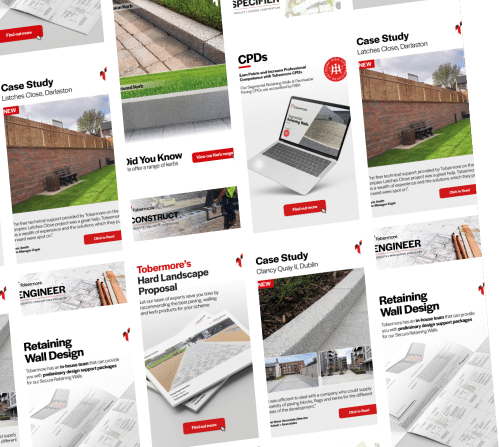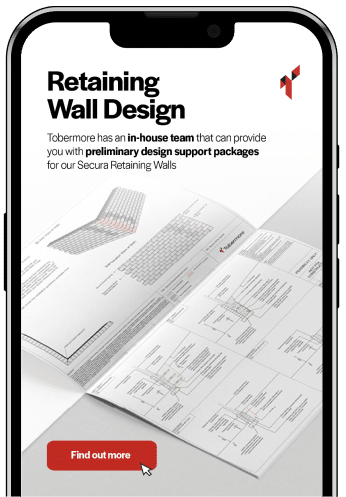-
What is permeable paving?
Permeable paving is a hard landscaping SuDs (sustainable drainage systems). These paving products are designed to allow water to pass through joints between paving materials whilst providing a stable, load bearing surface.
Tobermore’s Hydropave paving products reduce the risk of flooding and pollution by allowing water to pass through joint filling material in gaps between concrete paving blocks or flags into the underlying permeable sub-base.
-
If I have heavy traffic how do I strengthen the sub-base?
A punched layer of Dense Bitumen Macadam ( DBM ) can be used to strengthen the pavement sub-base. Alternatively Hydraulically Bound Coarse Graded aggregate can also be used. Guidance on this can be found in BS 7533 Part 13 or contact Tobermore for details.
-
What depth of sub-base is needed for Hydropave Permeable Paving?
This depends on the loading category, the CBR , the infiltration rate of the ground and how much water needs to be stored. Please contact Tobermore for assistance.
-
What aggregate is used for the sub-base in a Hydropave Permeable Paving system?
A 4/20mm coarse graded aggregate to BS EN13242:2002 / BS 7533 Part 13 should be used.
-
Is Hydropave Permeable Paving installed in the same way as non-permeable paving?
No. Hydropave is installed using a different method with different sub-base and jointing aggregates to allow for infiltration and storage of water. Please consult our installation guide here.
-
How do I install Hydropave Permeable Paving?
Specific guidance on how to install Hydropave Permeable Paving can be found here.
-
Can services be placed within Hydropave Permeable Paving sub-bases?
Ideally services should not be placed beneath areas of permeable paving. Best design practice is to place them under areas of conventional paving. This avoids the need to excavate areas of permeable paving to maintain these services.
-
Should I be concerned with frost heave?
Research studies carried out in some of the coldest climates in the USA have shown that permeable paving sub-bases are not affected by cold temperatures. There have been no cases of frost heave damaging Hydropave Permeable Pavements in the UK. When the correct aggregates are used in the sub-base they have a high void space ratio which means they drain quickly.
-
How should I maintain Hydropave Permeable Paving?
For optimum performance we recommend that paving is cleaned twice a year.
Please download our maintenance guidelines here.
-
Can I install Tobermore Hydropave Permeable Paving over Geocellular storage crates?
Yes, this can be done by installing a geotextile on top of the crates. The bedding layer of grit is then installed on top of the geotextile. Contact Tobermore for further guidance.
-
What material should be used to fill the joints when using Hydropave Permeable Paving?
A 6 – 2.3mm clean grit to BS EN 13242 should be used ensuring that the joints are completely filled. Joints should be topped up if necessary after use.
-
Do Tobermore have slip/skid results for Hydropave products?
Yes, these results are on the individual specification sheets which you can download from our website here.
-
Can permeable pavements be used on steeply sloping sites?
There are different design methods to cope with sloping sites. These include constructing check dams or baffles within the sub-base to restrict the flow or increasing the depth of the sub-base. The maximum gradient without the need for baffles is usually 1:20. Contact Tobermore for more information regarding sloping sites.
-
Which products in your range are permeable?
Products in our range which are prefixed by the word Hydropave are permeable. Find our full range of permeable paving products here.
-
How do I detail soft landscape areas adjacent to Permeable Paving?
It is important to prevent soil being washed onto the surface of permeable paving as it could clog up the joints. Detailing soft landscaping at the edge of permeable paving is especially important.
-
Is Permeable Paving more expensive than traditional paving?
When whole life costs are considered permeable paving systems can be more cost effective when compared to traditional pavements. When designing and constructing permeable pavements there is a reduction in the requirement for gullies, drainage pipes, manholes etc. Further savings can be made due to the fact that oil interceptors are often not required when using permeable paving due to it’s ability to clean the water.
-
Why should I choose Hydropave Permeable Paving?
Climate change in the UK means we are getting more rainfall events and the intensity of these events is increasing. Traditional drainage techniques are unable to cope with the extra surface water run-off. To help combat these issues the UK Government has introduced The Floods and Water Management Act 2010 ( England and Wales). This act aims to replace the traditional methods of handling surface water run-off with SuDs solutions. ( Sustainable Drainage Systems ) Permeable pavements are regarded as one of the most cost effective and useable SuDS methods of storing and infiltrating/filtering surface water.
To find out more read our Permeable Paving blog.
-
What is the design life of Hydropave Permeable Paving?
Hydropave Permeable Pavements are designed for a 25 year design life. For guidance please refer to BS7533 Part 13.
-
What is Tobermore Hydropave Permeable Paving laid on?
Tobermore Hydropave Permeable Paving should be laid on 6 – 2.3mm clean grit to BS EN 13242. The depth of this layer should be 50mm.
-
Will local authorities in England, Wales and Scotland adopt areas of Permeable Paving?
The number of local authorities who are adopting permeable pavements is increasing as they see the benefits of using it and understand that they are cost effective to maintain. See our permeable paving blog for more details.
-
How does Tobermore Hydropave Permeable Paving reduce surface water run-off?
Permeable pavements mimic natural water behaviour of undeveloped sites by allowing rainfall to infiltrate through the joints in the paving. Depending on the site conditions rain is allowed to either drain into the ground or attenuated and released slowly to secondary drainage systems. Typical flow rates for water exiting a permeable pavement are 2 to 7 l/s/ha (litres/second/hectare).
-
Does using Hydropave Permeable Paving improve water quality?
Worldwide research has shown that permeable pavement systems are very effective at cleaning and improving the quality of water entering them. A report by CIRIA ( Construction Industry Research and Information Association ) demonstrated that permeable pavement can remove 60 – 95% of suspended solids and 70 – 90% of hydrocarbons.
-
Can a Permeable Pavement be trafficked during the site construction process?
It is very important to ensure that the pavement is not contaminated during the construction process. Therefore it may be more practical to leave installation of the bedding material and paving blocks until most of the construction on the site is complete. The solution to this is to install the sub-base material and then overlay this with Dense Bitumen Macadam (DBM) to form a temporary site access road. Site traffic can then use this road for access during the construction phase. Once access by construction traffic is no longer needed the DBM layer can remain in place. The layer is firstly cleaned and then 75mm diameter holes are cored through to allow water to drain through to the sub-base aggregate. The 75mm diameter holes should be cored through on a 750 mm grid and filled with 6 – 2.3mm grit. The required thickness of the DBM layer required will be dependent on the amount of construction traffic using it.
-
Do Hydropave Permeable Pavements require lots of maintenance?
No, they actually require very little maintenance compared to the sometimes onerous maintenance required for traditional drainage systems which require gulley cleaning on a regular basis.
Tobermore Hydropave products ensure a high joint void width percentage to accommodate the correct grit grading, reducing maintenance and maximising drainage flow rates.
-
Is Hydropave permeable paving only suitable for car parking or can it be used on areas subjected to heavy traffic?
Whilst car parking is one of the most popular areas where Hydropave Permeable Paving is used, designed correctly to BS 7533 Part 13 it can also be used on areas with heavy traffic such as bus stations and roads.
Products
Back
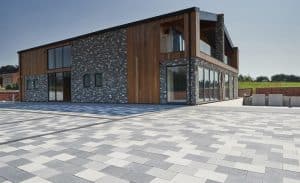 Block Paving
Block Paving Paving Flags
Paving Flags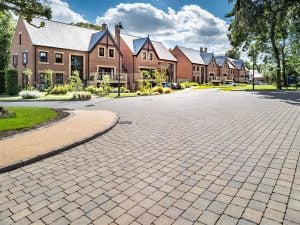 Permeable Paving
Permeable Paving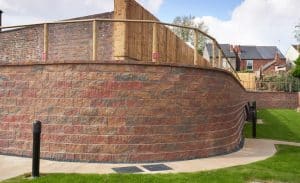 Retaining Walls
Retaining Walls Facing Bricks & Walling
Facing Bricks & Walling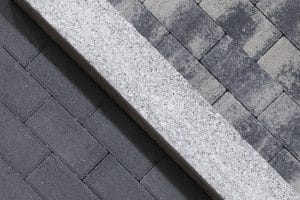 Kerbs & Edging
Kerbs & Edging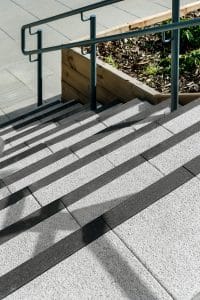 Steps
Steps